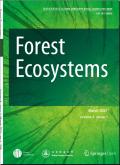通过在热带退化土地上恢复森林景观改善地下水补给和旱季流量的潜力
IF 4.4
1区 农林科学
Q1 FORESTRY
引用次数: 0
摘要
随着人们对热带森林恢复的兴趣加快,了解其水文含义变得越来越迫切。尽管人们仍然担心重新造林会减少年水量,特别是在干旱气候下,但我们强调了森林景观恢复(FLR)可以改善季节性水供应的条件,特别是在旱季。我们研究了在退化土地造林后增加的植被用水(“抽水”)与增强的渗透和地下滞留(“海绵”)之间的权衡,在特定的沿海和山地环境中植被捕获“隐蔽”降水(雾)的能力的恢复,以及森林覆盖在多个尺度上加强水分循环和输送的作用。一项泛热带敏感性分析表明,在土壤深厚且降雨季节性明显的退化景观中,造林后的入渗收益可以抵消或超过蒸发损失,从而在大约10%的情况下支持地下水补给并增加旱季流量,另有8%的情况显示出接近中性(略负)的结果。这些发现挑战了植树造林统一减少水可用性的假设,并强调了优先考虑旱季流量恢复(而不是年水量)作为FLR的中心水文目标的必要性。我们呼吁开展跨学科研究和长期监测,为森林恢复战略提供信息,特别是在缺水最严重的季节性干旱地区。本文章由计算机程序翻译,如有差异,请以英文原文为准。
Potential for improved groundwater recharge and dry-season flows through forest landscape restoration on degraded lands in the tropics
As interest in tropical forest restoration accelerates, understanding its hydrological implications is increasingly urgent. While concerns persist that reforestation will reduce annual water yields—particularly in drier climates—we highlight conditions under which forest landscape restoration (FLR) can improve seasonal water availability, especially during the dry season. We examine the trade-off between increased vegetation water use (“pumping”) and enhanced infiltration and subsurface retention (“sponging”) following forestation of degraded lands, the recovery of vegetation's ability to capture “occult” precipitation (fog) in specific coastal and montane settings, and the role of forest cover in enhancing moisture recycling and transport at multiple scales. A pan-tropical sensitivity analysis shows that in degraded landscapes with deep soils and pronounced rainfall seasonality, infiltration gains following forestation can offset or exceed evaporative losses, thereby supporting groundwater recharge and increasing dry-season flows in approximately 10% of cases, with an additional 8% showing near-neutral (slightly negative) outcomes. These findings challenge the assumption that forestation uniformly reduces water availability and underscore the need to prioritize dry-season flow recovery—rather than annual water yield—as a central hydrological goal of FLR. We call for trans-disciplinary research and long-term monitoring to inform forest restoration strategies, particularly in seasonally dry regions where water scarcity is most acute.
求助全文
通过发布文献求助,成功后即可免费获取论文全文。
去求助
来源期刊

Forest Ecosystems
Environmental Science-Nature and Landscape Conservation
CiteScore
7.10
自引率
4.90%
发文量
1115
审稿时长
22 days
期刊介绍:
Forest Ecosystems is an open access, peer-reviewed journal publishing scientific communications from any discipline that can provide interesting contributions about the structure and dynamics of "natural" and "domesticated" forest ecosystems, and their services to people. The journal welcomes innovative science as well as application oriented work that will enhance understanding of woody plant communities. Very specific studies are welcome if they are part of a thematic series that provides some holistic perspective that is of general interest.
 求助内容:
求助内容: 应助结果提醒方式:
应助结果提醒方式:


